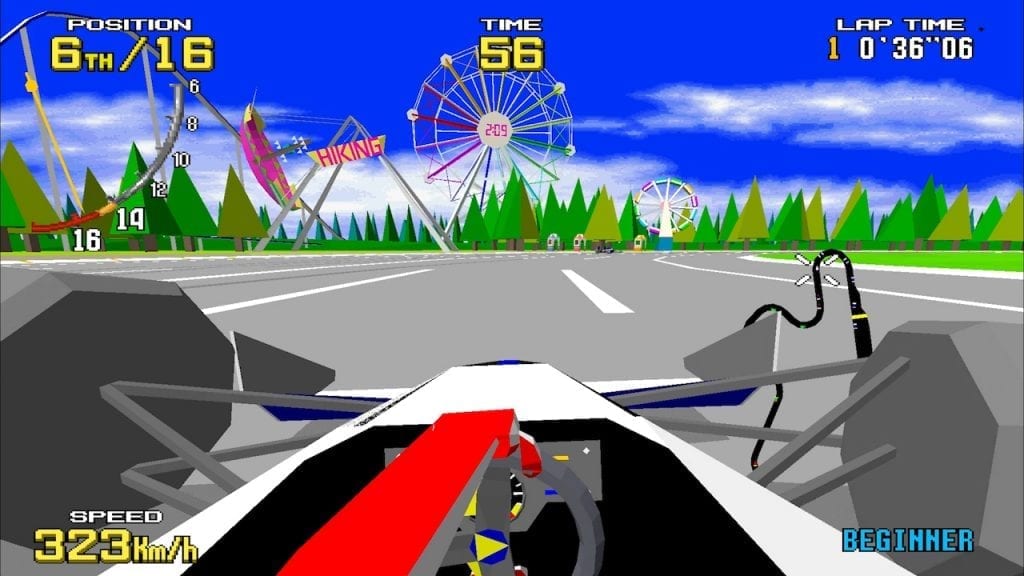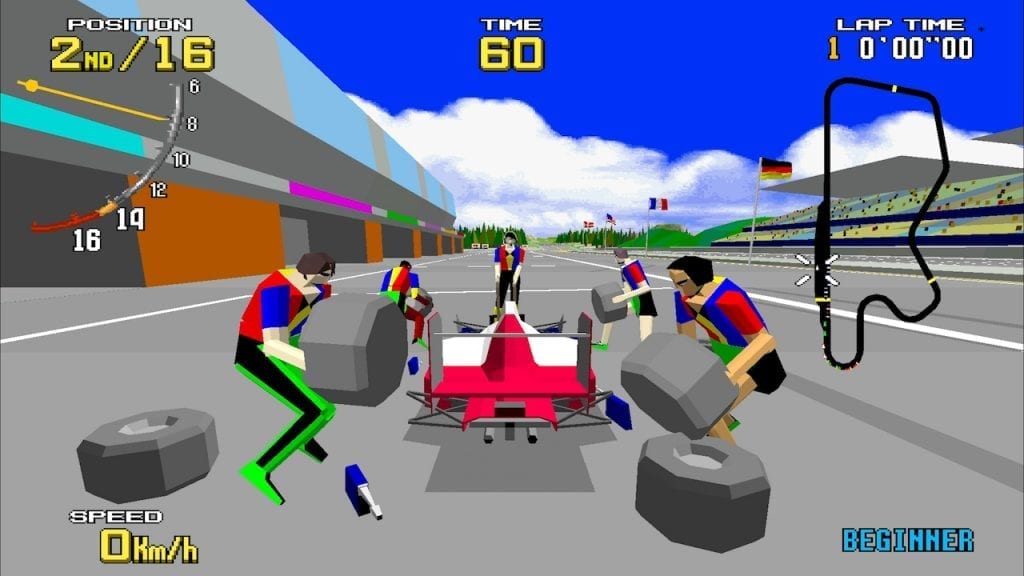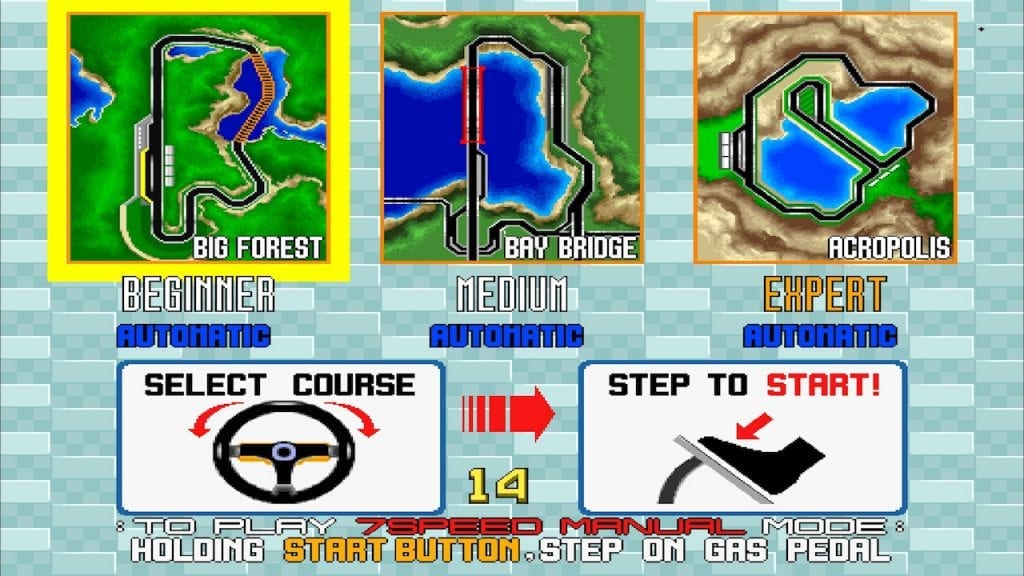Sega Ages on Nintendo Switch has been a gift for retro gamers.
M2 have given us over a dozen lovingly thought through and beautifully presented versions of Sega classics. As a racing game freak, I couldn’t wait to get my hands on Outrun over Christmas. It didn’t disappoint.
Imagine my excitement then, when I heard M2 were releasing Virtua Racing in February. Nearly fell off my gaming bed I did. Well…sofa bed. One day I will have a gaming bed dammit! But I digress…
Virtua Racing was the granddaddy of an era of incredible Sega arcade racers. Those of us who are of a certain vintage will remember visiting the racing floor of the now long-defunct Sega World at Trocadero in London. Daytona and Sega Rally Championship were endlessly playable (and endlessly play I did until Dreamcast’s immolation and Sega’s restructuring closed the place down!)
But nothing was as exciting to a teenage F1 fan as Virtua Racing. The polygon graphics, the liveries that were suspiciously like real F1 teams. The sound of those engines. The only question is: can M2 keep their streak going and deliver a Virtua Racing experience that lives up to my fuzzy teenage memories?
The bright, bouncy synth sounds that great you in the game menu are like a time machine. They instantly transport you to a place in the early 1990s. A place where the arcade still mattered. A place where home consoles couldn’t touch their coin-op counterparts. A place where Sega still bestrode the industry like a colossus. I like this place. It makes me happy.
One of the challenges in resurrecting these venerable classics is finding a balance between old and new. It goes without saying that the game must be faithful to its progenitor. But old arcade games didn’t come with shiny online connectivity. And we all know that kids today like online connectivity.
In my opinion Virtua Racing strikes an excellent balance. The original version of the game is presented with meticulous authenticity, making 40-somethings like me squeal with middle-aged delight. But there is also a new Online Match option allowing for long-range polygonal wheel banging among curious Millennials. What M2 really got right here is the simplicity of this option. It’s still the same Virtua Racing we love, just online.
There’s also an online ranking option. This is great fun for two reasons. Firstly, because you can see your best times blasted into cyberspace for your greater glory. But also, because you can download the top 50 times from each track as replays and watch how the pros do it. And by pros, I of course mean 12-year olds whose parents weren’t old enough to conceive when this game first hit the Arcade. Okay maybe watching these pipsqueaks humble my best efforts isn’t such a great option but still…
Onto the gameplay!

M2 have manged a very slick presentation. The aspect ratio has been broadened to a contemporary 16:9 and the frame rate upped to a silky smooth 60 FPS. Beyond that though those glorious polygon graphics have been presented in all their original splendour.
The Sega Model 1 arcade board was so astonishingly powerful in 1992 that some of the clumsiness of the graphics just didn’t matter. As a kid who cut his arcade racing teeth playing Pole Position on Brighton seafront in 1985, those 3D Model 1 graphics were absolutely mind blowing.
Perfect circles were immensely difficult for programmers to achieve in 3D in the 90s and in 2020 it’s hard to ignore the hilariously decahedral wheels. But if you’re worried that the experience will be like F1 driving with 50 pence pieces for tyres then Virtua Racing will surprise you. The gameplay itself is still thrilling.
Those accustomed to the modern Codemasters F1 games might take a while to get used to the physics of Virtua Racing. Like all good arcade games, it’s easy to play moderately well and really challenging to master. The cars seem to have an adhesion point right in the centre of the chassis. It’s like a nail has been driven through your airbox, attaching you to the road like a Scalextric car.
This means that your Virtua Racing machine can both understeer and oversteer quite alarmingly if you get your lines wrong. But there, my friends, lies the fun. In real life an F1 car is relatively simple for a good driver to manoeuvre round a track. Where it requires world class skill is in getting the car to the edge of its adhesion and keeping it there, lap after lap.

Virtua Racing’s physics capture this feeling perfectly. And if it’s not exactly an authentic single-seater physics engine it is still incredibly satisfying to put together a brilliant lap even after all these years. It’s also fun to fall off the road and watch your car bounce and fly through the air before landing totally undamaged to carry on. Ahhh, Arcade Gaming!
In order to replicate the throttle inputs of the original cabinet I strongly recommended accelerating and braking using the right thumb-stick. Other wise the power comes on like a switch (funny that) and you will crash. A lot. Well, I did.
And despite my advice, if crashing is all you seem to be doing with the Switch’s tiny thumb-sticks then there is a mode that simplifies the steering inputs and makes it impossible for you to collide with other cars. In other words, there’s a Wimp’s Mode!
In addition to the online and local multiplayer you can also select a Grand Prix mode. This will test your skill over 20 laps instead of the usual 5. And while it’s certainly fun to challenge yourself over a longer distance this feels like a sop to the inclinations of more modern gamers. It’s a shame that M2 didn’t add some of the extra tracks developed for the Saturn version instead.
What is wonderful is a cameo from Virt McPolygon. The Virtua Racing mascot and commentator extraordinaire will take you through a play-by-play of any Grand Prix length replays you decide to download. A very nice touch.

It would be remiss of me to conclude this review without discussing the car liveries. Sega arcade games of this era were insanely colourful to look at. So was the 1991 F1 grid. I don’t know if Sega sought a licence from F1’s management for Virtua Racing. What I do know is they based their car liveries on actual F1 team liveries so brazenly I’m surprised no lawyers got involved.
Your car is clearly meant to be Ayrton Senna’s iconic Marlboro McLaren Honda (even if you have a blue nosecone to prevent to connection being too obvious!) Joining you on the grid are cars that look suspiciously like the Williams, Jordan, Ferrari, Footwork, Benetton and Tyrell of 1991. Perhaps in these simpler times no one cared that Sega had pinched these liveries? Then again maybe everyone was having too much fun playing to notice!
If you play Grand Prix mode, you can actually change the livery of your car. This allows you to take on the fully authentic Marlboro McLaren livery. You can also choose from several different accent colours to match your vehicles white base. They even included yellow which means you can cosplay as Keke Rosberg in his one-off 1986 livery. Who knew M2 were such F1 historians!
Virtua Racing is another slam dunk for M2. The game is has never looked better and the controls capture the original experience beautifully. Also, the online features are a welcome addition. This release does lose a couple of marks though for not including the option to play the extra tracks from the Saturn version. But at £5.99 in the online store you really can’t go wrong. So grab your Switch and enjoy arcade racing as it was meant to be: bright, colourful, silly and FAST!







